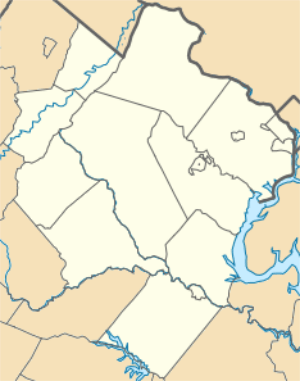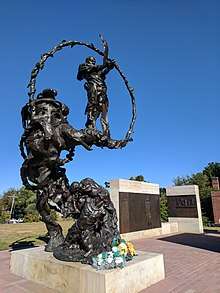Contrabands and Freedmen Cemetery
The Contrabands and Freedman Cemetery at 1001 S. Washington St. in Alexandria, Virginia was listed on the National Register of Historic Places on August 15, 2012.[1] It was established in February 1864 by the Union military commander of the Alexandria District for use as a cemetery for the burial of contrabands and freedmen. During early Reconstruction, it was operated by the Freedmen's Bureau. It was closed in late 1868, after Congress ended most operations of the Bureau. The last burial was made in January 1869.[3]
Contrabands and Freedmen Cemetery | |
   | |
| Location | 1001 S. Washington Street, Alexandria, Virginia |
|---|---|
| Coordinates | 38°47′40″N 77°02′59″W |
| NRHP reference No. | 12000516[1] |
| VLR No. | 100-0121-1085 |
| Significant dates | |
| Added to NRHP | August 15, 2012[1] |
| Designated VLR | June 21, 2012[2] |

The history was rediscovered in the late 20th century, and archeological techniques were used to identify its boundaries and burials. The land was acquired by the city and the cemetery re-established as a memorial in 2014.
Initially the Union Army buried soldiers of the United States Colored Troops here as well. But African-American troops in Alexandria's hospitals "demanded that blacks be given the honor of burial in the Soldiers' Cemetery, now Alexandria National Cemetery." In January 1865, the soldiers' remains were moved to the military cemetery.[3]
History
For African-American slaves who escaped bondage, the Union military occupation of Alexandria during the American Civil War created opportunity on an unprecedented scale. As Federal troops extended their occupation of the seceded states, escaped slaves flooded into Union-controlled areas. Safely behind Union lines, the cities of Alexandria and Washington offered not only comparative freedom, but employment for refugee slaves. Over the course of the war, Alexandria was transformed by the Union occupiers into a major supply depot and transport and hospital center, all under army control.[4]
Because the refugee slaves were still legally considered to be property of their owners, until the Emancipation Proclamation (January 1, 1863) freed them, they were classified by the Union Army as contrabands to prevent their being returned to former masters. Contrabands took positions with the army as construction workers, nurses and hospital stewards, longshoremen, painters, wood cutters, teamsters, laundresses, cooks, gravediggers, personal servants, and ultimately as soldiers and sailors. According to one statistic, the population of Alexandria had exploded to 18,000 by the fall of 1863 – an increase of 10,000 people in 16 months.[4]
When the Fifteenth Amendment was ratified in 1870, Alexandria County's black population was more than 8,700, or about half the total number of residents. This newly enfranchised constituency was instrumental to the election of the first black Alexandrians to the City Council and the Virginia Legislature.[5]
The population of contrabands flooding into Alexandria during the Union occupation included many who were destitute, malnourished, and in poor health. Once in Alexandria, the contrabands were housed in barracks and hastily assembled shantytowns. In such close quarters, with poor sanitation, smallpox and typhoid outbreaks were prevalent and death was common, as it was in most military encampments.
In February 1864, after hundreds of contrabands and freedmen had died, the commander of the Alexandria military district, General John P. Slough, confiscated a parcel of undeveloped land at the corner of South Washington and Church streets from a pro-Confederate owner to be used as a cemetery specifically for burial of contrabands. Burials started in March that year.[6]
The cemetery operated under General Slough's command. Its oversight was supervised by Alexandria's Superintendent of Contrabands, the Rev. Albert Gladwin, who made arrangements for burials. Each grave was identified with a whitewashed, wooden grave marker.[5] In 1868, after Congress ended most functions of the Freedmen's Bureau, the cemetery was closed. The government returned the property to its original owners. Eventually, after the grave markers had rotted and ownership had transferred several times, the property was redeveloped for commercial use. During its five years of operation, about 1,800 contrabands and freedmen were buried in the cemetery.[6]
.jpg)
Rediscovery of the Cemetery
The Cemetery disappeared from city maps after 1939; a gas station and an office building were built on the site.[7] It contained about 1800 burials. Beginning in 1987, when the history of the cemetery was rediscovered, it began to received more attention. Archeological surveys in relation to construction of the Woodrow Wilson Bridge included use of ground penetrating radar (GPR) to determine the presence of graves. Some excavations also took place in order to locate surviving interments.[7]
In 1997 the Friends of Freedmen Cemetery was organized to raise public awareness of the cemetery and support for its preservation. The City of Alexandria began the process of acquiring land and saving the cemetery to create a memorial park.
During 2008, the city accepted submissions in a design competition for the memorial were received from 20 countries, and a design for the memorial cemetery by C.J. Howard of Alexandria was selected. The cemetery was opened in September 2014, including a sculpture, The Path of Thorns and Roses by Mario Chiodo, at the center of the park.[8]
As Contrabands and Freedmen Cemetery, the cemetery was listed on the U.S. National Register of Historic Places in August 2012. It was added in 2015 to the National Park Service's National Underground Railroad Network to Freedom, a series of designated sites related to the history of slaves escaping bondage.
Historical markers
A historical marker erected in 2000 by the Virginia Department of Historic Resources reads:
Freedmen's Cemetery Federal authorities established a cemetery here for newly freed African Americans during the Civil War. In January 1864, the military governor of Alexandria confiscated for use as a burying ground an abandoned pasture from a family with Confederate sympathies. About 1,700 people, including infants and black Union soldiers, were interred here before the last recorded burial in January 1869. Most of the deceased had resided in what is known as Old Town and in nearby rural settlements. Despite mid-twentieth-century construction projects, many burials remain undisturbed. A list of those interred here has also survived.
The list of those interred is posted at the Memorial, together with the historic note:
Besides the school in the barracks there are others in the city, which are self sustaining, containing one hundred and fifty pupils. It is an astonishing fact, which ought to be placed upon record ... [ellipsis in the original] that out of the two thousand people collected at Alexandria, there are four hundred children sent daily to school. The first demand of these fugitives when they come into the place is, that their children may go to school.[9]
References
- "New listings, week of August 24, 2012".
- "Virginia Landmarks Register". Virginia Department of Historic Resources. Archived from the original on 2013-09-21. Retrieved 2013-05-12.
- "Contrabands and Freedmen Cemetery Memorial: Cemetery History", City of Alexandria website
- "Office of Historic Alexandria, Alexandria Freedmen's Cemetery: Historical Overview, April 2007, p. 2" (PDF). Archived from the original (PDF) on 2012-03-24. Retrieved 2012-01-29.
- Freed People and Freedmen's Cemetery – Alexandria, Virginia.
- "Office of Historic Alexandria, Alexandria Freedmen's Cemetery: Historical Overview, April 2007, p. 3" (PDF). Archived from the original (PDF) on 2012-03-24. Retrieved 2012-01-29.
- City of Alexandria. "Archeology at Alexandria's Freedmen's Cemetery. A Memorial in Progress" (PDF). Retrieved February 15, 2018.
- "Contrabands and Freemen Cemetery Memorial Construction". Retrieved 2018-01-02.
- City of Alexandria, VA (February 14, 2018). "Photo Gallery of Contrabands and Freedmen Cemetery". Retrieved February 15, 2018.
External links
| Wikimedia Commons has media related to Contrabands and Freedmen Cemetery. |
- Contrabands and Freedmen Cemetery Memorial - City of Alexandria
- "A graveyard resurrected", Folklife, Smithsonian Institution

